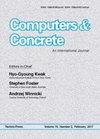基于非局部应变梯度理论的FG-SWCNTs增强多孔纳米复合粘弹性板振动分析
IF 3.3
4区 工程技术
Q2 COMPUTER SCIENCE, INTERDISCIPLINARY APPLICATIONS
引用次数: 2
摘要
考虑非局部应变梯度理论,研究了单壁功能梯度碳纳米管(FG-SWCNTs)增强多孔纳米复合材料粘弹性板的尺寸依赖效应。因此,利用能量法和哈密顿原理,推导了运动方程。本文研究了非局部参数、长径比、应变梯度参数、碳纳米管体积分数、阻尼系数、孔隙率系数和温度变化对固有频率的影响。本文的创新之处在于分别比较上述各参数对该板的自由振动的影响,并表示每个参数的适当值,以实现振动最小化的理想纳米复合材料板。所得结果与文献资料相吻合。结果表明,阻尼系数对固有频率增加的影响显著高于其他参数的影响,应变梯度参数和非局部参数对固有频率增加的影响分别小于阻尼系数的影响。结果表明,随着非局部参数、宽高比和温度变化的增加,固有频率降低。固有频率随应变梯度参数和CNTs体积分数的增加而增加。通过考虑纳米复合材料板的理想性能,本研究可用于优化工业和医疗设计,如汽车工业、航空航天工程和水净化系统。本文章由计算机程序翻译,如有差异,请以英文原文为准。
Vibration analysis of porous nanocomposite viscoelastic plate reinforced by FG-SWCNTs based on a nonlocal strain gradient theory
This paper investigates the size dependent effect on the vibration analysis of a porous nanocomposite viscoelastic plate reinforced by functionally graded-single walled carbon nanotubes (FG-SWCNTs) by considering nonlocal strain gradient theory. Therefore, using energy method and Hamilton\'s principle, the equations of motion are derived. In this article, the effects of nonlocal parameter, aspect ratio, strain gradient parameter, volume fraction of carbon nanotubes (CNTs), damping coefficient, porosity coefficient, and temperature change on the natural frequency are perused. The innovation of this paper is to compare the effectiveness of each mentioned parameters individually on the free vibrations of this plate and to represent the appropriate value for each parameter to achieve an ideal nanocomposite plate that minimizes vibration. The results are verified with those referenced in the paper. The results illustrate that the effect of damping coefficient on the increase of natural frequency is significantly higher than the other parameters effect, and the effects of the strain gradient parameter and nonlocal parameter on the natural frequency increase are less than damping coefficient effect, respectively. Furthermore, the results indicate that the natural frequency decreases with a rise in the nonlocal parameter, aspect ratio and temperature change. Also, the natural frequency increases with a rise in the strain gradient parameter and CNTs volume fraction. This study can be used for optimizing the industrial and medical designs, such as automotive industry, aerospace engineering and water purification system, by considering ideal properties for the nanocomposite plate.
求助全文
通过发布文献求助,成功后即可免费获取论文全文。
去求助
来源期刊

Computers and Concrete
工程技术-材料科学:表征与测试
CiteScore
8.60
自引率
7.30%
发文量
0
审稿时长
13.5 months
期刊介绍:
Computers and Concrete is An International Journal that focuses on the computer applications in be considered suitable for publication in the journal.
The journal covers the topics related to computational mechanics of concrete and modeling of concrete structures including
plasticity
fracture mechanics
creep
thermo-mechanics
dynamic effects
reliability and safety concepts
automated design procedures
stochastic mechanics
performance under extreme conditions.
 求助内容:
求助内容: 应助结果提醒方式:
应助结果提醒方式:


